Bluffing your way in Chinese - Cambridge University Library ...
Bluffing your way in Chinese - Cambridge University Library ...
Bluffing your way in Chinese - Cambridge University Library ...
You also want an ePaper? Increase the reach of your titles
YUMPU automatically turns print PDFs into web optimized ePapers that Google loves.
Sandars Lectures <strong>in</strong> Bibliography 2008<br />
Peter Kornicki<br />
Professor of East Asian Studies, <strong>University</strong> of <strong>Cambridge</strong><br />
Lecture 2: Tuesday 11 March<br />
<strong>Bluff<strong>in</strong>g</strong> <strong>your</strong> <strong>way</strong> <strong>in</strong> Ch<strong>in</strong>ese<br />
As I mentioned <strong>in</strong> the previous lecture, Ch<strong>in</strong>ese texts enjoyed enormous<br />
esteem outside Ch<strong>in</strong>a and they were widely held to embody religious, ethical<br />
and political lessons that were well worth dissem<strong>in</strong>at<strong>in</strong>g. Read<strong>in</strong>g them,<br />
however, required learn<strong>in</strong>g literary Ch<strong>in</strong>ese, and that was a daunt<strong>in</strong>g prospect<br />
at the best of times and def<strong>in</strong>itely not likely to help them achieve anyth<strong>in</strong>g like<br />
wide diffusion. This was a formidable difficulty and it was met by devis<strong>in</strong>g<br />
strategies for translation, adaptation and simplification us<strong>in</strong>g the vernacular<br />
languages of Japan, Korea and Vietnam. This made it possible for Japanese,<br />
Koreans and Vietnamese to ga<strong>in</strong> access to Ch<strong>in</strong>ese texts, and even to read<br />
them, without actually hav<strong>in</strong>g to learn literary Ch<strong>in</strong>ese. This is what I mean by<br />
‘bluff<strong>in</strong>g <strong>your</strong> <strong>way</strong> <strong>in</strong> Ch<strong>in</strong>ese’.<br />
Yesterday I focused on the transmission of Ch<strong>in</strong>ese books to other East<br />
Asian societies; now it is time to draw a little closer to what Samuel Sandars<br />
meant by bibliography, that is, to consider the material forms that Ch<strong>in</strong>ese<br />
texts took and how non-Ch<strong>in</strong>ese readers set about tackl<strong>in</strong>g them. This is what I<br />
shall be focus<strong>in</strong>g upon <strong>in</strong> this lecture, but towards the end I shall also address<br />
the need to unpick the loose and unsatisfactory term ‘Ch<strong>in</strong>ese texts’, which I<br />
have been us<strong>in</strong>g <strong>in</strong>discrim<strong>in</strong>ately so far. This is because the selections of<br />
Ch<strong>in</strong>ese texts to be studied and dissem<strong>in</strong>ated differed across East Asian space<br />
and time, and the mean<strong>in</strong>gs made of them were neither stable <strong>in</strong> any one<br />
society nor were they consistent between different societies.<br />
* * *<br />
Ch<strong>in</strong>ese manuscripts orig<strong>in</strong>ally came without word spac<strong>in</strong>g and without<br />
punctuation or any other divisions whatsoever, just like the manuscripts which<br />
transmitted the Greek and Lat<strong>in</strong> texts of antiquity up to the late middle ages.<br />
Word spac<strong>in</strong>g is to this day still alien to written Ch<strong>in</strong>ese, and to written<br />
Japanese for that matter, partly because it is far from easy to decide what<br />
constitutes a word <strong>in</strong> Ch<strong>in</strong>ese, but more importantly because to some extent<br />
the characters themselves mark the morphemic boundaries <strong>in</strong> written Ch<strong>in</strong>ese
2<br />
and thus fulfil the function achieved by gaps between words <strong>in</strong> European<br />
languages. Punctuation, however, is a different matter altogether, and many a<br />
faulty <strong>in</strong>terpretation has depended upon misplaced punctuation, <strong>in</strong> Ch<strong>in</strong>ese<br />
just as <strong>in</strong> English; <strong>in</strong>deed there are not a few passages <strong>in</strong> Ch<strong>in</strong>ese classical<br />
texts where disputed punctuation gives rise to disputed <strong>in</strong>terpretations. It is no<br />
surprise, then, to discover from the oldest surviv<strong>in</strong>g manuscripts that there was<br />
not only a felt need for punctuation but, more importantly, that add<strong>in</strong>g<br />
punctuation was a crucial stage <strong>in</strong> the process of read<strong>in</strong>g. Before you could<br />
beg<strong>in</strong> to construe and to read a text <strong>in</strong> Ch<strong>in</strong>ese, you had to be able to punctuate<br />
it. The history of punctuation is not the most thrill<strong>in</strong>g of subjects; nevertheless,<br />
the ability to read an unpunctuated text <strong>in</strong> literary Ch<strong>in</strong>ese was one that was<br />
limited to a t<strong>in</strong>y scholarly elite <strong>in</strong> East Asia for most of the last thousand<br />
years, so we do need to take some account of the difference that punctuation<br />
made. 1<br />
By far the largest corpus of early Ch<strong>in</strong>ese manuscripts available to us today<br />
is the huge cache found by Sir Aurel Ste<strong>in</strong> and others at Dunhuang <strong>in</strong> far<br />
western Ch<strong>in</strong>a <strong>in</strong> the early years of the twentieth century. Some of these f<strong>in</strong>ds<br />
are fragmentary and consist of cont<strong>in</strong>uous text without punctuation. Many of<br />
the Dunhuang manuscripts, however, show clear signs of attempts to tame the<br />
raw Ch<strong>in</strong>ese, to make it more easily comprehensible, by add<strong>in</strong>g punctuation.<br />
There were fundamentally two <strong>way</strong>s of add<strong>in</strong>g some basic punctuation and<br />
other aids to the reader; one, the more obvious, was to use a brush and to write<br />
the desired additions onto the surface of the manuscript, us<strong>in</strong>g black, white or<br />
red <strong>in</strong>k; the other <strong>way</strong> is more mysterious and we will come to that <strong>in</strong> a<br />
moment. In some manuscripts we f<strong>in</strong>d that not only have spaces been <strong>in</strong>serted<br />
between sections of the manuscript to aid readers, but also that these breaks<br />
have been marked out by brush <strong>in</strong> red <strong>in</strong>k. This is punctuation at its most<br />
basic.<br />
The obvious question with many surviv<strong>in</strong>g manuscripts – and this applies<br />
equally to pr<strong>in</strong>ted texts with punctuation added by hand – is precisely when<br />
the punctuation was added. In the case of many Dunhuang manuscripts, we do<br />
1<br />
On punctuation <strong>in</strong> Ch<strong>in</strong>ese texts, see Jean-Pierre Drège, ‘la lecture et l’écriture en Ch<strong>in</strong>e<br />
et la xylographie’, Études ch<strong>in</strong>oises 10 (1991), pp. 88-90; Christoph Harbsmeier, Language<br />
and logic, Part 1 of volume 7 of Joseph Needham, Science and civilization <strong>in</strong> Ch<strong>in</strong>a<br />
(<strong>Cambridge</strong> <strong>University</strong> Press, 1998), pp. 175-180; Wolfgang Behr & Bernhard Führer,<br />
‘E<strong>in</strong>führende Notizen zum Lesen <strong>in</strong> Ch<strong>in</strong>a mit besonderer Berücksichtigung der Frühzeit’,<br />
<strong>in</strong> Bernhard Führer, ed., Aspekte des Lesens <strong>in</strong> Ch<strong>in</strong>a <strong>in</strong> Vergangenheit und Gegenwart<br />
(Bochum: project verlag, 2005), pp. 33-42.
3<br />
not know exactly when it was added, though it cannot have been after the<br />
eleventh century, when it is thought that somebody sealed up the caves <strong>in</strong><br />
which the Dunhuang manuscripts were kept. That, of course, is not a very<br />
satisfactory means of dat<strong>in</strong>g; it just gives us a term<strong>in</strong>us ante quem.<br />
On the other hand, if we now turn to an example of the Vimalakīrt<strong>in</strong>irdeśa<br />
sūtra [ 維 摩 經 義 記 ] found at Dunhuang, we have a much better idea, for it<br />
conveniently carries two colophons expla<strong>in</strong><strong>in</strong>g the circumstances of its<br />
production. 2 Accord<strong>in</strong>g to the first colophon, the manuscript was copied <strong>in</strong> the<br />
year 539 and then checked; accord<strong>in</strong>g to the second colophon, 23 years later,<br />
<strong>in</strong> the year 562, a monk used this manuscript for lectur<strong>in</strong>g purposes and added<br />
punctuation with a red brush. The significance of this second colophon is the<br />
delay of twenty-three years, for it is evident that punctuation was at this stage<br />
extraneous to the text and that add<strong>in</strong>g it was a private act for the lecturer’s<br />
own convenience; that is why copies of Buddhist sutras which were copied <strong>in</strong><br />
a uniform format and were <strong>in</strong>tended for monastic library use do not as a rule<br />
carry punctuation, while private copies, or students’ copies, or copies that<br />
were liberated from libraries, very often do conta<strong>in</strong> punctuation, and it is<br />
generally written <strong>in</strong> a different colour from the black <strong>in</strong>k of the text so that the<br />
orig<strong>in</strong>al state of the unpunctuated text is preserved. 3 Colophons like these<br />
seem to have been written with the future scholar <strong>in</strong> m<strong>in</strong>d, and they are far<br />
from unusual; from this particular example we can see that already by the<br />
sixth century private readers were accustomed to add<strong>in</strong>g punctuation to texts.<br />
What exactly do I mean by ‘punctuation’ The earliest forms to appear<br />
divided the raw Ch<strong>in</strong>ese text <strong>in</strong>to sections, <strong>in</strong>to sentences and <strong>in</strong>to <strong>in</strong>ternal<br />
divisions with<strong>in</strong> sentences. Punctuation of this sort can be found not only <strong>in</strong><br />
Ch<strong>in</strong>ese texts produced <strong>in</strong> Ch<strong>in</strong>a, but also <strong>in</strong> copies made <strong>in</strong> Japan and Korea;<br />
<strong>in</strong> all likelihood the same was true of copies made <strong>in</strong> Vietnam, but <strong>in</strong>vasions,<br />
wars and the climate have left us with not a s<strong>in</strong>gle Vietnamese manuscript that<br />
can be safely dated to any time before the sixteenth century. Still, there can be<br />
little doubt that basic punctuation techniques were transmitted from Ch<strong>in</strong>a to<br />
all parts of East Asia where Ch<strong>in</strong>ese texts were read.<br />
This sort of punctuation is not the end of the story, however; other marks<br />
were used, for example to identify proper names, to <strong>in</strong>dicate the tones with<br />
which the characters were to be pronounced and to dist<strong>in</strong>guish between two<br />
2<br />
Ishizuka Harumichi, ‘Rōran Tonkō no katenbon’, Bokubi 201 (1970), pp. 2-38, and<br />
‘Tonkō no katenbon’, <strong>in</strong> Tonkō kanbun bunken, Kōza Tonkō vol. 5 (Taitō Shuppansha,<br />
1992), pp. 239-40. The item is Or.8210/S. 2732 <strong>in</strong> the British <strong>Library</strong>; images have not yet<br />
been loaded onto the website of the International Dunhuang Project:<br />
http://idp.bl.uk/idp.a4d.<br />
3<br />
Ishizuka, ‘Tonkō no katenbon’, p. 241.
4<br />
different senses of one and the same character. In other words, punctuation<br />
was be<strong>in</strong>g used <strong>in</strong>creas<strong>in</strong>gly to tie down the <strong>in</strong>terpretation of the text. Given<br />
that pr<strong>in</strong>ted texts seldom carried punctuation, and when they did it was<br />
rudimentary, the need to punctuate also applied to pr<strong>in</strong>ted books, obviously.<br />
For this reason many an old pr<strong>in</strong>ted book is found to conta<strong>in</strong> various types of<br />
punctuation and annotation laboriously provided by an early reader. 4<br />
What we have been look<strong>in</strong>g at so far is the use of the writ<strong>in</strong>g brush to<br />
punctuate an exist<strong>in</strong>g manuscript or a pr<strong>in</strong>ted text <strong>in</strong> Ch<strong>in</strong>ese and this method<br />
was widespread <strong>in</strong> Japan and Korea, but, as I have already mentioned, it was<br />
not the only method available. The other method, the mysterious one, has only<br />
come to light <strong>in</strong> the last fifty years, and the reason for that is that it took<br />
considerable imag<strong>in</strong>ation to realise that various small <strong>in</strong>dentations <strong>in</strong> the paper<br />
of early manuscripts were not accidental but rather were marks made<br />
deliberately with the sharpened end of a writ<strong>in</strong>g brush or with some other<br />
sharp implement. S<strong>in</strong>ce this technique was first brought to light <strong>in</strong> Japan <strong>in</strong><br />
1961, I shall use the Japanese name for it, kakuhitsu 角 筆 , for it was not until<br />
the year 2000 that the first examples of this practice were identified <strong>in</strong> Korea,<br />
where it is called kakp’il. It is a technique that is similar to the ‘dry-po<strong>in</strong>t<br />
gloss’ as used <strong>in</strong> European medieval manuscripts. The follow<strong>in</strong>g Korean<br />
example (fig. 3), taken from a facsimile of a pr<strong>in</strong>ted copy of the Flower<br />
Garland sutra [Avataṃsaka sūtra; (K) H<strong>way</strong>ŏmgyŏng 華 厳 經 ] belong<strong>in</strong>g to the<br />
first Korean pr<strong>in</strong>t<strong>in</strong>g of the Buddhist canon <strong>in</strong> the eleventh century illustrates<br />
the practice of kakuhitsu/kakp’il. To the naked or at least untra<strong>in</strong>ed eye, this<br />
text appears to have no punctuation or annotations whatsoever. A closer look,<br />
however, reveals that there are <strong>in</strong> fact a large number of <strong>in</strong>dentations which<br />
have been deliberately made <strong>in</strong> the surface of the paper, and these are <strong>in</strong> the<br />
facsimile conveniently highlighted <strong>in</strong> yellow for ease of identification.<br />
Indentations like this have also been found <strong>in</strong> Ch<strong>in</strong>ese manuscripts from<br />
Dunhuang which date back to the fifth century. There is no <strong>way</strong> of know<strong>in</strong>g if<br />
those <strong>in</strong>dentations were made soon after the manuscripts were copied <strong>in</strong> the<br />
fifth century or much later. However, <strong>in</strong> the British Museum there is a copy of<br />
the Lotus sūtra [ 妙 法 蓮 華 經 観 世 音 菩 薩 普 門 品 第 二 十 五 ] dated 948 from<br />
Dunhuang and accord<strong>in</strong>g to the colophon this was punctuated and edited by<br />
the copyist <strong>in</strong> the same year <strong>in</strong> order to read it aloud; where he – for the<br />
copyist was a monk – found a dubious or a mistaken character, he crossed it<br />
out with the sharp end of his brush, thus leav<strong>in</strong>g it visible, and wrote at the<br />
4<br />
Ibid., passim.
5<br />
side <strong>in</strong> <strong>in</strong>k what <strong>in</strong> his view was the correct read<strong>in</strong>g. 5 So the use of<br />
<strong>in</strong>dentations for edit<strong>in</strong>g purposes <strong>in</strong> Ch<strong>in</strong>a goes back at least that far, the year<br />
948.<br />
5<br />
Kobayashi Yosh<strong>in</strong>ori, ‘Tonkō no kakuhitsu bunken – Daiei toshokanzō Kannongyō<br />
(S.5556) no katen’, Kuntengo to kunten shiryō 96 (1995), pp. 3-4. This item is Or.8210/S.<br />
5556 <strong>in</strong> the British <strong>Library</strong>.
6<br />
Fig. 3. Flower Garland Sutra [H<strong>way</strong>ŏmgyŏng 華 厳 経 ], 巻 36<br />
pr<strong>in</strong>ted <strong>in</strong> Korea ca 1100. Taken from I Sŭngjae et al., eds, Kukbo ibaeksaho<br />
chubon H<strong>way</strong>ŏmgyŏng kwŏn samsimnyuk (P’aju: T’aehaksa, 2006), p. 79.<br />
[picture removed for copyright reasons]
7<br />
There is much work still to be done on the Dunhuang manuscripts and<br />
doubtless some other examples will come to light which we can confidently<br />
give an earlier date to. For the time be<strong>in</strong>g, however, although hard evidence is<br />
want<strong>in</strong>g, it is difficult to escape the conclusion that this practice of<br />
punctuat<strong>in</strong>g and mak<strong>in</strong>g corrections by means of <strong>in</strong>dented marks was first<br />
developed <strong>in</strong> Ch<strong>in</strong>a and later transmitted from Ch<strong>in</strong>a to Korea and Japan.<br />
What we see <strong>in</strong> the Korean examples, however, is a quantity of <strong>in</strong>dentations<br />
that far exceeds anyth<strong>in</strong>g that can be found <strong>in</strong> any of the Dunhuang<br />
manuscripts. Indentations <strong>in</strong> the Dunhuang manuscripts were either be<strong>in</strong>g used<br />
for editorial purposes or were fulfill<strong>in</strong>g the same role as punctuation marks<br />
conventionally <strong>in</strong>serted with brush and <strong>in</strong>k. So what could the huge number of<br />
<strong>in</strong>dentations we see here possibly signify, and why were they used to such a<br />
great extent <strong>in</strong> manuscripts and pr<strong>in</strong>ted books outside Ch<strong>in</strong>a<br />
When I was talk<strong>in</strong>g about punctuation a few m<strong>in</strong>utes ago I was not really<br />
talk<strong>in</strong>g about ‘bluff<strong>in</strong>g <strong>your</strong> <strong>way</strong> through Ch<strong>in</strong>ese,’ as the title of this lecture<br />
has it, so much as about break<strong>in</strong>g the text down <strong>in</strong>to its constituent parts and<br />
provid<strong>in</strong>g useful aids to comprehension. Now, however, we need to take<br />
account of the phenomenon known <strong>in</strong> Japanese as kundoku 訓 読 , that is, the<br />
habit of try<strong>in</strong>g to read Ch<strong>in</strong>ese as if it were <strong>your</strong> own language, and that is the<br />
po<strong>in</strong>t of all these <strong>in</strong>dentations.<br />
It has become abundantly clear that, at least by the eighth century, it was a<br />
common practice <strong>in</strong> Korea and Japan to read Ch<strong>in</strong>ese as if it were <strong>your</strong> own<br />
language, and it was certa<strong>in</strong>ly also practised by speakers of Uyghur and<br />
Vietnamese as well. 6 Perhaps the easiest <strong>way</strong> of expla<strong>in</strong><strong>in</strong>g kundoku is to<br />
compare it to the representation of a bit of arithmetical notation such as<br />
2 + 2 = 4 <strong>in</strong> Arabic numerals; this can be read <strong>in</strong> any language follow<strong>in</strong>g the<br />
normal syntactic rules that apply <strong>in</strong> that language: <strong>in</strong> writ<strong>in</strong>g it means the same<br />
to speakers of any language, but when spoken out loud it only makes sense to<br />
those who speak the same language. In a similar, but not quite identical,<br />
manner, readers <strong>in</strong> Japan and Korea devised <strong>way</strong>s of read<strong>in</strong>g a Ch<strong>in</strong>ese text <strong>in</strong><br />
a manner that conformed to the syntax of the Japanese or the Korean<br />
language; thus, like a piece of arithmetical notation, the text meant the same to<br />
any reader but was articulated <strong>in</strong> quite different <strong>way</strong>s accord<strong>in</strong>g to the<br />
language spoken by the reader. This process started even before the<br />
development of the Japanese and Korean scripts, so we can def<strong>in</strong>itely say that<br />
6<br />
Kamigaito Masahiro, ‘Bunken kenkyū to gengogaku – Uigurugo ni okeru kanjion no<br />
saikō to kanbun kundoku no kanōsei’, Gengo kenkyū 124 (2003), pp. 1-36; Nguyen Thi<br />
Oanh, ‘Nihon kara mita Betonamu kanbun kundoku’, unpublished paper delivered at the<br />
Book Roads conference <strong>in</strong> Hangzhou, September 2006.
8<br />
it is decidedly not a product of the emergence of those scripts. In other words,<br />
the drive to vernacularize Ch<strong>in</strong>ese texts came first, and it anticipated, and<br />
possibly even stimulated, the emergence of vernacular scripts.<br />
Consider, for example, the case of a Ch<strong>in</strong>ese commentary on the Flower<br />
Garland sutra [(J) Kegon kanjōki 華 厳 刊 定 記 ]. 7 Sometime <strong>in</strong> the middle of<br />
the eighth century, a copy of this commentary was made at the Tōdaiji temple<br />
<strong>in</strong> Nara; several detailed colophons tell us that <strong>in</strong> 783 and 788 this Japanese<br />
copy was checked aga<strong>in</strong>st a copy imported from Korea and then aga<strong>in</strong>st a<br />
copy imported from Tang Ch<strong>in</strong>a, and a little later more editorial work was<br />
done on the manuscript. Each stage of this editorial work was carried out <strong>in</strong><br />
<strong>in</strong>k of a different colour, show<strong>in</strong>g extraord<strong>in</strong>arily k<strong>in</strong>d attention to the needs of<br />
future scholars. When the whole process had been completed, by the year 806<br />
at the latest, the manuscript had been doubly authenticated by compar<strong>in</strong>g it<br />
with imported copies from both Korea and Ch<strong>in</strong>a; it conta<strong>in</strong>ed not only the<br />
k<strong>in</strong>d of punctuation marks <strong>in</strong> common use <strong>in</strong> Tang Ch<strong>in</strong>a but <strong>in</strong> addition it<br />
conta<strong>in</strong>ed Ch<strong>in</strong>ese numerals to <strong>in</strong>dicate the order <strong>in</strong> which the Ch<strong>in</strong>ese<br />
characters were to be read <strong>in</strong> accordance with Japanese syntax. From this the<br />
conclusion is <strong>in</strong>escapable: the readers of this text <strong>in</strong> late eighth-century Japan<br />
were bluff<strong>in</strong>g their <strong>way</strong> <strong>in</strong> Ch<strong>in</strong>ese, not so much read<strong>in</strong>g the Ch<strong>in</strong>ese text as<br />
generat<strong>in</strong>g a Japanese text from it; that is, they were reta<strong>in</strong><strong>in</strong>g the Ch<strong>in</strong>ese<br />
vocabulary but rearrang<strong>in</strong>g it <strong>in</strong> Japanese order and add<strong>in</strong>g Japanese<br />
grammatical elements and <strong>in</strong>flections so that it made sense as Japanese.<br />
This late eighth-century manuscript is the oldest Japanese witness to this practice<br />
so far identified, and it is important to remember that this is not a scriptural text but<br />
a commentary: while Buddhist sutras might be, and for centuries were, <strong>in</strong>toned<br />
straight from the Ch<strong>in</strong>ese text, albeit <strong>in</strong> Japanese or Korean pronunciation, this<br />
particular text is a commentary, and the glosses are there <strong>in</strong> order to facilitate an<br />
entirely different k<strong>in</strong>d of read<strong>in</strong>g operation, one <strong>in</strong> which comprehension is the goal<br />
by means of on-the-spot creation of a Japanese version.<br />
Another example of the same practice comes from a twelfth-century Japanese<br />
manuscript <strong>in</strong> a private collection (fig. 4). The illustration shows the end of the<br />
manuscript with the two colophons, one <strong>in</strong> black and one <strong>in</strong> red; these attest to the<br />
act of copy<strong>in</strong>g the manuscript and then of edit<strong>in</strong>g it. The significant po<strong>in</strong>t here,<br />
however, is the quantity of dots <strong>in</strong> red <strong>in</strong>k scattered on and around the characters at<br />
the end of the text on the right hand side, an arrangement that might recall all those<br />
<strong>in</strong>dentations seen around the characters <strong>in</strong> the Korean pr<strong>in</strong>ted text.<br />
7 O M<strong>in</strong>yŏng and Kim Sŏngju, ‘Daitōkyū K<strong>in</strong>en Bunko zō Kegon kanjōki ni tsuite’,<br />
Kuntengo to kunten shiryō 119 (2007), pp. 100-32.
9<br />
Fig. 4. Bianzheng lun 辨 正 論 , copied by a monk of the Hōryūji temple <strong>in</strong> Nara <strong>in</strong><br />
1123. Taken from the frontispiece of Tsukishima Hiroshi, Heian jidai kuntenbon<br />
ronkō (Tokyo: Kyūko Sho<strong>in</strong>, 1996).<br />
[picture removed for copyright reasons]
10<br />
Both the Japanese and the Korean languages rely upon particles follow<strong>in</strong>g nouns<br />
to <strong>in</strong>dicate syntactic relations and upon verbal <strong>in</strong>flections to <strong>in</strong>dicate tense, aspect<br />
and negativity. How were these essential features to be <strong>in</strong>dicated <strong>in</strong> a Ch<strong>in</strong>ese text if<br />
you wanted to read it <strong>in</strong> <strong>your</strong> own language at a time when there was no script<br />
available to write Japanese or Korean The answer was a set of <strong>in</strong>dentations, or<br />
alternatively marks made with a brush, all carefully placed to discrim<strong>in</strong>ate between<br />
different syntactical relations.<br />
Let us consider one example of how this worked <strong>in</strong> Japan (fig. 5). 8 Here can<br />
be seen various types of brushstroke; the various positions of each type of<br />
brushstroke are arranged <strong>in</strong> a square, with one or more <strong>in</strong> the middle; these<br />
show the positions of brushstrokes added by a reader on or around a given<br />
Ch<strong>in</strong>ese character. These marks are known <strong>in</strong> Japanese as okototen and the<br />
small letters beside them tell us what <strong>in</strong>flections or particles they represented.<br />
If we take just the set of brush marks <strong>in</strong> the top right, and show how they are<br />
used with an <strong>in</strong>dividual character, the complexity of this scheme will be all too<br />
apparent (fig. 6). The kana syllabic signs beside the dots, helpfully added <strong>in</strong><br />
the most authoritative study of okototen to date, <strong>in</strong>dicate their functions; thus<br />
the simple dot placed immediately above the character represents the<br />
accusative particle and makes the character the object of some verb; <strong>in</strong> the<br />
same <strong>way</strong>, the dots <strong>in</strong> the other positions place the character <strong>in</strong> one or another<br />
of several possible syntactic relationships it can enjoy with other words <strong>in</strong> a<br />
sentence; the dashes and various other brushstrokes <strong>in</strong> fig. 5 <strong>in</strong>creased the<br />
range of syntactical <strong>in</strong>formation that could be conveyed <strong>in</strong> this <strong>way</strong>. Complex<br />
though this scheme is, what I have shown here is merely the scheme of marks<br />
used <strong>in</strong> the great Tōdaiji temple <strong>in</strong> Nara; at other temples of learn<strong>in</strong>g, different<br />
sets of marks were <strong>in</strong> use, for each major temple had its own set of texts and<br />
<strong>way</strong>s of read<strong>in</strong>g them, and it has taken decades of pa<strong>in</strong>stak<strong>in</strong>g research to<br />
work out what all the marks mean <strong>in</strong> a text like this. 9<br />
It has been a much-debated question for some years whether this <strong>way</strong> of<br />
read<strong>in</strong>g Ch<strong>in</strong>ese, kundoku, was an <strong>in</strong>dependent development <strong>in</strong> Japan or<br />
whether it was transmitted from Korea. Unlike Japan, Korea is not blessed<br />
with an abundance of very early manuscripts, for <strong>in</strong>vasions and wars have<br />
taken their toll; consequently, Japanese evidence of kundoku read<strong>in</strong>g is older<br />
than anyth<strong>in</strong>g that survives <strong>in</strong> Korea; that is an <strong>in</strong>escapable fact.<br />
8<br />
9<br />
Toll<strong>in</strong>i furnishes the best account <strong>in</strong> a Western language, esp. pp. 181ff.<br />
Tsukishima provides an exhaustive treatment.
Fig. 5. Okototen used <strong>in</strong> the Tōdaiji temple <strong>in</strong> Nara: taken from Tsukishima<br />
Hiroshi, Heian jidai kuntenbon ronkō – okototenzu kanajitai hyō (Tokyo:<br />
Kyūko Sho<strong>in</strong>, 1986), p. 90.<br />
11
12<br />
Fig. 6. The dots from the top right square of Fig. 5 superimposed on the<br />
Ch<strong>in</strong>ese character for ‘writ<strong>in</strong>g’. Based on Tsukishima Hiroshi, Heian jidai<br />
kuntenbon ronkō – okototenzu kanajitai hyō, p. 90.<br />
書<br />
Nevertheless, for two good reasons, the probability is that the practice was<br />
not <strong>in</strong>dependently developed <strong>in</strong> Japan. The first reason is the close similarity<br />
<strong>in</strong> techniques between the eighth-century Japanese examples and the later<br />
Korean ones, with the assumption be<strong>in</strong>g that the technique is more likely to<br />
have been transmitted from Korea to Japan, rather than the other <strong>way</strong> round,<br />
for that was the usual direction of flow for manuscripts and other cultural<br />
goods. As for the second reason, the fact is that the earliest Japanese<br />
manuscripts reveal<strong>in</strong>g the kundoku technique are all connected with the<br />
Flower Garland sect (Kegonshū 華 厳 宗 ) of Buddhism, and the teach<strong>in</strong>gs of<br />
this sect were transmitted to Japan <strong>in</strong> the year 740 by a Japanese monk who<br />
had spent some years study<strong>in</strong>g <strong>in</strong> Korea. When coupled with documentary<br />
evidence that Korean monks were generat<strong>in</strong>g Korean texts from Ch<strong>in</strong>ese
13<br />
sutras by the eighth century, this has been enough to conv<strong>in</strong>ce Japanese<br />
scholars that kundoku read<strong>in</strong>g was <strong>in</strong>deed <strong>in</strong>troduced to Japan from Korea. 10<br />
Convenient though the kundoku method certa<strong>in</strong>ly was, there can be no<br />
doubt that hav<strong>in</strong>g to read texts by rely<strong>in</strong>g on <strong>in</strong>dentations or small brushmarks<br />
left a lot to be desired. In other words, there was a much more that could be<br />
done to assist readers wrestl<strong>in</strong>g with Ch<strong>in</strong>ese texts. In particular, the<br />
development of the kana syllabic script <strong>in</strong> Japan <strong>in</strong> the n<strong>in</strong>th century made it<br />
possible to adopt more transparent methods and to reduce still further the<br />
difficulty of read<strong>in</strong>g Ch<strong>in</strong>ese. At first, and for many centuries, this was done<br />
by hand, either <strong>in</strong> manuscripts or <strong>in</strong> pr<strong>in</strong>ted books. For example, a text pr<strong>in</strong>ted<br />
<strong>in</strong> Japan as late as 1595 carried no aids to read<strong>in</strong>g whatsoever; a reader<br />
therefore went through it add<strong>in</strong>g a lot of syntactical elaboration <strong>in</strong> kana by<br />
hand, thus transform<strong>in</strong>g it <strong>in</strong>to a text that made sense as Japanese (fig. 7).<br />
Some at least of these aids to the reader could of course easily be pr<strong>in</strong>ted,<br />
and <strong>in</strong> Japan they frequently were, but only from the seventeenth century<br />
onwards. This can be illustrated with a glance at the 1634 Japanese edition of<br />
the Zen classic, the Platform Sutra of the sixth patriarch [(J) Rokuso dankyō<br />
六 祖 段 經 ] (fig. 8). As you can see, the pr<strong>in</strong>ted text has been assiduously<br />
punctuated <strong>in</strong> red and annotated <strong>in</strong> black <strong>in</strong> 1645 by a scholar-monk who<br />
conveniently dated his handwritten annotations to the text. It is important,<br />
however, to notice the extent of the apparatus already present <strong>in</strong> the text<br />
before he got to work on it, and we can see this more easily <strong>in</strong> the attached<br />
enlargement of the top four characters of the seventh l<strong>in</strong>e. The various marks<br />
visible <strong>in</strong> the enlargement, the numerals on the left and the Japanese<br />
<strong>in</strong>flections and particles on the right, were all part of the pr<strong>in</strong>ted text; they<br />
provided the clues to enable Japanese readers to place the characters <strong>in</strong> the<br />
Japanese order, and to construe this Ch<strong>in</strong>ese text as if it were Japanese. Even<br />
this was not enough to enable the learned monk <strong>in</strong> the seventeenth century to<br />
read it with ease: with red <strong>in</strong>k he ruled red l<strong>in</strong>es through the proper names and<br />
he added much more besides <strong>in</strong> black <strong>in</strong>k.<br />
Glosses of this sort were common <strong>in</strong> all Ch<strong>in</strong>ese texts pr<strong>in</strong>ted <strong>in</strong> Japan after<br />
1620 or so, and it will be obvious that the presentation of texts <strong>in</strong> this <strong>way</strong> not<br />
only made Ch<strong>in</strong>ese texts more accessible but also militated strongly <strong>in</strong> favour<br />
of the use of woodblock pr<strong>in</strong>t<strong>in</strong>g. Ch<strong>in</strong>ese texts were be<strong>in</strong>g pr<strong>in</strong>ted <strong>in</strong> Japan<br />
with a bewilder<strong>in</strong>g encrustation of t<strong>in</strong>y numerals, added particles and<br />
pronunciation glosses. This was easy enough to achieve <strong>in</strong> pr<strong>in</strong>t us<strong>in</strong>g wood<br />
blocks, but fiendishly difficult to do with movable type, and this is the<br />
10 Kobayashi Yosh<strong>in</strong>ori, ‘Kankoku ni okeru kakuhitsu bunken no hakken to sono igi –<br />
Nihon kokunten to no kankei’, Chōsen gakuhō 182 (2002), pp. 53-57.
14<br />
Fig. 7. A Tang-dynasty study of the Lotus sutra pr<strong>in</strong>ted <strong>in</strong> Kyoto <strong>in</strong> 1595<br />
(<strong>University</strong> <strong>Library</strong>). 11 Only the Ch<strong>in</strong>ese text is pr<strong>in</strong>ted; all the other marks are<br />
handwritten additions to facilitate read<strong>in</strong>g.<br />
11<br />
UL: FG.710.106; Hayashi and Kornicki, no. 2372.
Fig. 8. Platform sutra of the sixth patriarch, 1634 Japanese edition with<br />
handwritten additions dated 1645 (author’s collection), with enlargement of<br />
the first four characters of the seventh l<strong>in</strong>e to show pr<strong>in</strong>ted glosses.<br />
15
16<br />
pr<strong>in</strong>cipal factor, it seems to me, that expla<strong>in</strong>s why typography was abandoned<br />
<strong>in</strong> Japan <strong>in</strong> the seventeenth century after just fifty years of use. For a<br />
commercial publisher seek<strong>in</strong>g to make texts accessible, all the glosses were<br />
essential and yet they added enormously to the effort and the expense of<br />
prepar<strong>in</strong>g a typographic edition. This, then, is surely why woodblock pr<strong>in</strong>t<strong>in</strong>g<br />
became once aga<strong>in</strong> the dom<strong>in</strong>ant form of pr<strong>in</strong>t<strong>in</strong>g <strong>in</strong> Japan right up to the<br />
1880s.<br />
Let us turn now to Korea and consider how access to Ch<strong>in</strong>ese texts was<br />
facilitated there, for it is quite a different story. As <strong>in</strong> Japan, for a long time<br />
<strong>in</strong>dentations or brush-marks were used, but these were <strong>in</strong>sufficient to help<br />
readers construe the text, and by the n<strong>in</strong>th century abbreviated characters were<br />
be<strong>in</strong>g used to amplify the syntactic relationships. These glosses, denoted<br />
kugyŏl 口 訣 and t’o 吐 <strong>in</strong> Korean, were used to generate a Korean text from<br />
the Ch<strong>in</strong>ese by <strong>in</strong>dicat<strong>in</strong>g grammatical particles and <strong>in</strong>flections. 12 This is a<br />
similar procedure to that adopted <strong>in</strong> Japan, so rather than discuss<strong>in</strong>g this <strong>in</strong><br />
detail I shall <strong>in</strong>stead consider late developments <strong>in</strong> Korea, which have no<br />
parallel <strong>in</strong> Japan.<br />
After the <strong>in</strong>vention of the hangŭl alphabetic script <strong>in</strong> 1443, it became<br />
possible to provide even more help to Korean readers of Ch<strong>in</strong>ese texts. It<br />
would be a mistake, however, to equate the <strong>in</strong>vention of hangŭl with a new<br />
commitment to the vernacular. After all, the afterword of the 1446 edition of<br />
Correct sounds to <strong>in</strong>struct the people [Hunm<strong>in</strong> chŏngŭm 訓 民 正 音 ], the<br />
famous book that publicised the new script, made it clear that one of the<br />
advantages of hangŭl was that it would help people to understand Ch<strong>in</strong>ese<br />
texts:<br />
Although our country’s rituals, music, and literature are comparable to<br />
those of Ch<strong>in</strong>a, our speech and language are not the same as Ch<strong>in</strong>a’s.<br />
Those who studied books <strong>in</strong> Ch<strong>in</strong>ese were concerned about the difficulty<br />
of understand<strong>in</strong>g their mean<strong>in</strong>g and purport. 13<br />
In fact, for several centuries to follow, by far the most common use of hangŭl<br />
<strong>in</strong> pr<strong>in</strong>t was <strong>in</strong> what are called ŏnhaebon 諺 解 本 , which are books conta<strong>in</strong><strong>in</strong>g<br />
Ch<strong>in</strong>ese texts with Korean explanatory material. 14 These are, <strong>in</strong> other words,<br />
12<br />
For an explanation <strong>in</strong> English, see Peter H. Lee, ed., A history of Korean literature<br />
(<strong>Cambridge</strong> <strong>University</strong> Press, 2003), pp. 88-90; Yu T’ag’il, Hanguk munhŏnhak yŏngu<br />
(Seoul: Asia Munhwasa, 1989), p. 51ff.<br />
13<br />
Peter H. Lee, ed, Sourcebook of Korean civilization, volume 1 (New York: Columbia<br />
<strong>University</strong> Press, 1993), p. 517.<br />
14<br />
The only thorough study of ŏnhaebon as a phenomenon is Hong Yunp’yo, Kŭndae kugŏ<br />
yŏngu, vol. 1 (Seoul: T’aehansa, 1994), pp. 113-127.
17<br />
Fig. 9. Eighteenth-century edition of the Great learn<strong>in</strong>g (author’s collection)<br />
with an enlargement of the first part of the first l<strong>in</strong>e of text to show Korean<br />
glosses follow<strong>in</strong>g each character and, at the bottom, a Korean grammatical<br />
particle.
18<br />
hybrid books, consist<strong>in</strong>g on the one hand of a Ch<strong>in</strong>ese text transmitted from<br />
Ch<strong>in</strong>a, and on the other hand of Korean explanatory material.<br />
The form that ŏnhaebon typically took is shown <strong>in</strong> fig. 9. This shows the<br />
open<strong>in</strong>g page of an eighteenth-century edition of the Great Learn<strong>in</strong>g, one of<br />
the canonical Four Books. First of all, the reader is given the orig<strong>in</strong>al Ch<strong>in</strong>ese<br />
text on the right, but, as you see, it is a very complex mis-en-page that we<br />
have <strong>in</strong> front of us, for each character comes with its conventional Korean<br />
pronunciation below it <strong>in</strong> hangŭl, and <strong>in</strong> addition Korean grammatical<br />
particles and other forms are <strong>in</strong>serted to help the reader generate a Korean<br />
version of the Ch<strong>in</strong>ese text. Then, on the left, the reader is offered a translation<br />
of the Ch<strong>in</strong>ese text <strong>in</strong>to Korean; the translation, as you see, reta<strong>in</strong>s some items<br />
of Ch<strong>in</strong>ese vocabulary, each aga<strong>in</strong> with their conventional Korean<br />
pronunciations shown, but it is <strong>in</strong>dubitably <strong>in</strong> the Korean language rather than<br />
<strong>in</strong> Ch<strong>in</strong>ese.<br />
The earliest books of this k<strong>in</strong>d were produced <strong>in</strong> the second half of the<br />
fifteenth century, thus not long after the <strong>in</strong>vention of hangŭl. At this early<br />
stage they consisted not of Confucian texts but mostly of Buddhist texts and of<br />
the writ<strong>in</strong>gs of Ch<strong>in</strong>ese poets of the Tang dynasty. In 1461 a government<br />
agency was set up precisely <strong>in</strong> order to pr<strong>in</strong>t Buddhist texts, and two years<br />
later it produced a hybrid text of the Lotus Sutra; this was one of the most<br />
popular sutras <strong>in</strong> Korea and at least 120 different editions were pr<strong>in</strong>ted<br />
between 1399 and 1876, but the significance of the hybrid editions, of course,<br />
is that they gave access to the text to those whose knowledge of Buddhist<br />
Ch<strong>in</strong>ese was not perfect. Given the importance that the Four Books and the<br />
Five Classics had <strong>in</strong> education and <strong>in</strong>tellectual life <strong>in</strong> Korea, it will come as<br />
someth<strong>in</strong>g of a surprise to learn that these were not among the first texts to be<br />
produced <strong>in</strong> handy hybrid editions; quite to the contrary. This very fact alerts<br />
us to a crucial dimension of these editions: by translat<strong>in</strong>g a Ch<strong>in</strong>ese text <strong>in</strong>to<br />
Korean, the translator had to decide upon one <strong>in</strong>terpretation of the text rather<br />
than another. This caused few problems <strong>in</strong> the case of most Ch<strong>in</strong>ese texts, but<br />
<strong>in</strong> Korea it created huge difficulties <strong>in</strong> the case of canonical works like the<br />
Four Books. Why should that have been so<br />
The edition of the Four Books and the Five Classics that was widely used <strong>in</strong><br />
Korea, from the foundation of the Chosŏn dynasty <strong>in</strong> 1392 onwards, was a<br />
M<strong>in</strong>g edition that was repr<strong>in</strong>ted <strong>in</strong> Korea <strong>in</strong> 1427. 15 But <strong>in</strong> this edition the texts<br />
were <strong>in</strong> raw Ch<strong>in</strong>ese, naturally with Ch<strong>in</strong>ese commentary supplied but without<br />
any read<strong>in</strong>g aids whatsoever; they were therefore of no conceivable use to the<br />
15<br />
Kim Hangsu, ‘Simnyuk segi kyŏngsŏ ŏnhae ŭi sasangjŏk koch’al’, Kyujanggak 10<br />
(1987), p. 19.
19<br />
poor student. Successive k<strong>in</strong>gs recognised this and ordered that hybrid<br />
editions with Korean translations be prepared, but years, decades passed and<br />
surpris<strong>in</strong>gly little progress was made. One of the reasons was that some<br />
scholars were very uneasy about the idea of establish<strong>in</strong>g a set of official<br />
translations for the Ch<strong>in</strong>ese classics and pr<strong>in</strong>t<strong>in</strong>g them, for that would fix the<br />
<strong>in</strong>terpretation of those texts for good and leave scholars little room for<br />
discuss<strong>in</strong>g difficult passages and com<strong>in</strong>g up with alternative <strong>in</strong>terpretations.<br />
Thus when the first draft of a version of part of the Five Classics was<br />
prepared, a dispute broke out between those who favoured the <strong>in</strong>terpretations<br />
of the lead<strong>in</strong>g Ch<strong>in</strong>ese Neo-Confucianist, Zhu Xi, and those who favoured<br />
other <strong>in</strong>terpretations; this was no storm <strong>in</strong> a teacup, for one of the participants<br />
argued that the dissenters on the other side should be executed. Intellectual<br />
dissent was <strong>in</strong> fact a dangerous bus<strong>in</strong>ess dur<strong>in</strong>g the Chosŏn dynasty, so it was<br />
only after many years of factional disputation and organizational difficulty<br />
that <strong>in</strong> 1585 a government office was f<strong>in</strong>ally created to put an end to the<br />
delays and produce hybrid editions of the core texts. 16<br />
The first result of their labours was <strong>in</strong> fact an edition of the Lesser<br />
Learn<strong>in</strong>g, a work produced <strong>in</strong> the Song dynasty as an <strong>in</strong>troduction to the ethics<br />
and pr<strong>in</strong>cipals of Confucianism. Mastery of this work was considered <strong>in</strong> Korea<br />
essential before more serious scholarly work was undertaken; and candidates<br />
for the civil service exam<strong>in</strong>ations had to demonstrate that they had already<br />
passed an exam<strong>in</strong>ation on their knowledge of this work before they were<br />
allowed to proceed to the higher exams. 17 This hybrid edition, therefore, was<br />
prepared with the needs of serious students <strong>in</strong> m<strong>in</strong>d. In other words, this was<br />
not an edition for the benefit of those who could not read Ch<strong>in</strong>ese; rather it<br />
was an aid to study, a version of the text with appropriate glosses and an<br />
accurate translation that was <strong>in</strong>tended to lead the student towards a full<br />
understand<strong>in</strong>g of the syntax and the mean<strong>in</strong>g of the Ch<strong>in</strong>ese text. There was a<br />
translation provided all right, but it was subord<strong>in</strong>ate to the ma<strong>in</strong> purpose,<br />
which was to <strong>in</strong>struct the student how to read the Ch<strong>in</strong>ese aloud <strong>in</strong> such a <strong>way</strong><br />
that it made some sort of sense <strong>in</strong> Korean.<br />
Eventually, <strong>in</strong> 1588 this office produced a complete hybrid edition of the<br />
Four Books, all based on the <strong>in</strong>terpretations of Zhu Xi, and these became the<br />
standard editions; they were repr<strong>in</strong>ted frequently, which is an eloquent<br />
16<br />
Ibid., passim. Mart<strong>in</strong>a Deuchler, ‘Despoilers of the Way, <strong>in</strong>sulters of the Sages:<br />
controversies over the Classics <strong>in</strong> seventeenth-century Korea’, <strong>in</strong> JaHyun Kim Haboush and<br />
Mart<strong>in</strong>a Deuchler, eds, Culture and the state <strong>in</strong> late Chosŏn Korea (Harvard <strong>University</strong><br />
Press, 1999), pp. 91-133.<br />
17<br />
Kim Hangsu, pp. 18-19.
20<br />
testimony to the need for them. But it also <strong>in</strong>dicates the clos<strong>in</strong>g down of room<br />
for different <strong>in</strong>terpretations and the imposition of officially sanctioned modes<br />
of <strong>in</strong>terpretation of these texts. Produc<strong>in</strong>g these hybrid editions had clearly<br />
been a struggle. However, once the ideological or factional l<strong>in</strong>e of<br />
<strong>in</strong>terpretation had been laid down, a flood of hybrid editions appeared, and<br />
emphasis gradually moved from the Ch<strong>in</strong>ese orig<strong>in</strong>als to the Korean<br />
translations, as we shall see <strong>in</strong> the third lecture.<br />
By contrast with what happened <strong>in</strong> Korea, this particular leap from orig<strong>in</strong>al<br />
to translation was never made <strong>in</strong> Japan, at least when it came to Ch<strong>in</strong>ese<br />
Confucian texts. Instead, there was a different development <strong>in</strong> Japan, the<br />
mass-market<strong>in</strong>g of Confucian texts. From the 1780s onwards, a series of<br />
editions <strong>in</strong> an unusual format was published, beg<strong>in</strong>n<strong>in</strong>g <strong>in</strong> 1786 with the Four<br />
Books; the series went by the name of ‘Classics without a teacher’ [Keiten<br />
yoshi 經 典 餘 師 ] and it was created by Tani Hyakunen 溪 百 年 . There was a<br />
lot that was new about these editions, to start off with the size: <strong>in</strong>stead of the<br />
larger sizes associated with scholarly books, these were smaller and <strong>in</strong>vited<br />
comparison <strong>in</strong>stead with works of popular fiction (fig. 10). This series was<br />
immensely successful: the edition of the Four Books, for example, was pr<strong>in</strong>ted<br />
so many times that the woodblocks had worn out <strong>in</strong> eight years and a new set<br />
of blocks had to be prepared <strong>in</strong> 1794. This was followed by a third set of<br />
blocks <strong>in</strong> 1824, a fourth <strong>in</strong> 1842, a fifth <strong>in</strong> 1852 and even a sixth <strong>in</strong> 1871. 18<br />
S<strong>in</strong>ce each new set of blocks required a renewed capital <strong>in</strong>vestment <strong>in</strong> the<br />
wood and the labour of carv<strong>in</strong>g, there is strong evidence here of substantial<br />
returns and a large market. It is very much a moot po<strong>in</strong>t how many copies<br />
could be pr<strong>in</strong>ted from a set of blocks before they became illegible, but we are<br />
safe <strong>in</strong> assum<strong>in</strong>g at least eight thousand copies, so we have evidence here of at<br />
least 50,000 copies com<strong>in</strong>g onto the market. 19<br />
What exactly did readers get out of these books Accord<strong>in</strong>g to the prefaces,<br />
they were aimed at rural readers who had to make do without a teacher to<br />
<strong>in</strong>struct them how to read Ch<strong>in</strong>ese texts. So readers were provided with a text<br />
conta<strong>in</strong><strong>in</strong>g cont<strong>in</strong>uous glosses <strong>in</strong> Japanese, as you can see, so that he or she<br />
could articulate the entire text <strong>in</strong> Japanese either aloud, as was often done <strong>in</strong><br />
schools, or <strong>in</strong> silence. In addition to the cont<strong>in</strong>ual glosses, the texts also<br />
claimed to offer a translation; but what this translation turns out to be is<br />
<strong>in</strong>stead a commentary and a paraphrase rather than the sort of translation we<br />
18<br />
Suzuki Toshiyuki, Edo no dokushonetsu – jigaku suru dokusha to shoseki ryūtsū<br />
(Heibonsha, 2007), p. 157ff.<br />
19<br />
On the number of copies that could be pr<strong>in</strong>ted from woodblocks, see McDermott, pp.<br />
20-21.
21<br />
Fig. 10. The open<strong>in</strong>g of the third Keiten yoshi edition (1824) of the<br />
Great learn<strong>in</strong>g from the <strong>University</strong> <strong>Library</strong>. 20<br />
20<br />
UL FB.734.2; Hayashi and Kornicki, no. 2423.
22<br />
f<strong>in</strong>d <strong>in</strong> the Korean hybrid books. The enormous popularity of these books<br />
testifies not so much simply to a desire for access to the contents, but rather<br />
access to the language, the procedures and the learn<strong>in</strong>g associated with<br />
s<strong>in</strong>ology, with the forms of knowledge and the cultural capital that had <strong>in</strong> the<br />
seventeenth century been restricted to samurai and were now becom<strong>in</strong>g<br />
accessible to a much larger public through cheap editions like this. Village<br />
headmen, for example, had urgent need of this knowledge, for they had to<br />
correspond with their samurai masters <strong>in</strong> a bastardized form of Ch<strong>in</strong>ese and<br />
they needed to know the language of Confucian benevolence when they had to<br />
plead for reduced taxes when the village’s harvest had failed, for example. 21<br />
The popularity of these books, then, reveals the mass appeal that classic<br />
Ch<strong>in</strong>ese texts could enjoy even <strong>in</strong> the n<strong>in</strong>eteenth century.<br />
It is clear from these books that <strong>in</strong> Japan the def<strong>in</strong>itions of what constitute<br />
desirable knowledge were clearly still heavily biased towards s<strong>in</strong>ology, but it<br />
was now becom<strong>in</strong>g accessible through books that bypassed the longstand<strong>in</strong>g<br />
expectation that knowledge is transmitted by teachers belong<strong>in</strong>g to one<br />
particular school of thought. This is do-it-<strong>your</strong>self s<strong>in</strong>ology with a vengeance,<br />
and its appeal is evident not only from the multiple editions but also from the<br />
numerous copy-cat versions that also appeared. 22 The ends served by these<br />
editions would not <strong>in</strong> fact have been served by translations. In fact, it was only<br />
<strong>in</strong> the late n<strong>in</strong>eteenth century that Japanese translations appeared, <strong>in</strong> other<br />
words once s<strong>in</strong>ology was be<strong>in</strong>g replaced <strong>in</strong> the school curricula by English<br />
and was beg<strong>in</strong>n<strong>in</strong>g to lose its social cachet.<br />
There were <strong>in</strong>deed translations of other Ch<strong>in</strong>ese texts <strong>in</strong>to Japanese,<br />
<strong>in</strong>clud<strong>in</strong>g novels and medical works, but not of the canonical works of<br />
Confucianism that rema<strong>in</strong>ed the basis of the education system; with these you<br />
had to struggle to learn the rules for decod<strong>in</strong>g Ch<strong>in</strong>ese, but that was of<br />
practical value to the poor village headman, to say noth<strong>in</strong>g of the prestige<br />
attached to s<strong>in</strong>ological knowledge.<br />
I have spent some time show<strong>in</strong>g how Japanese and Korean readers became<br />
accustomed to read<strong>in</strong>g Ch<strong>in</strong>ese texts without necessarily hav<strong>in</strong>g a good<br />
understand<strong>in</strong>g of the Ch<strong>in</strong>ese language. There can be no doubt that<br />
Vietnamese were do<strong>in</strong>g the same, but the evidence is only now com<strong>in</strong>g to light<br />
and much further work is needed. The read<strong>in</strong>g marks that Japanese and<br />
Koreans put <strong>in</strong> their manuscripts, and likewise the read<strong>in</strong>g marks which came<br />
to be <strong>in</strong>cluded <strong>in</strong> pr<strong>in</strong>ted editions, show us that it was customary <strong>in</strong> Japan and<br />
21<br />
Richard Rub<strong>in</strong>ger, Popular literacy <strong>in</strong> early modern Japan (Honolulu: <strong>University</strong> of<br />
Hawai’i Press, 2007), passim.<br />
22<br />
Suzuki, chapter 4.
23<br />
Korea to rearrange the order of the Ch<strong>in</strong>ese characters mentally or aloud and<br />
to force them <strong>in</strong>to the straitjacket of their own languages, someth<strong>in</strong>g that was<br />
just not possible <strong>in</strong> the case of Lat<strong>in</strong>. It is important now to recognise that<br />
there were <strong>in</strong> fact other <strong>way</strong>s of approach<strong>in</strong>g Ch<strong>in</strong>ese texts.<br />
Take, for example, the Jurchens of north-east Ch<strong>in</strong>a: they spoke an<br />
agglut<strong>in</strong>ative language and therefore faced similar problems deal<strong>in</strong>g with<br />
Ch<strong>in</strong>ese writ<strong>in</strong>g to those faced by Japanese and Koreans. In the early twelfth<br />
century they overran most of northern Ch<strong>in</strong>a and established there the J<strong>in</strong><br />
dynasty; they devised a script for their language, adopted the Ch<strong>in</strong>ese practice<br />
of graded exam<strong>in</strong>ations for public office and <strong>in</strong> 1173 established an Academy<br />
to encourage learn<strong>in</strong>g. More significantly, <strong>in</strong> 1164 they had established a<br />
bureau for the translation of the Ch<strong>in</strong>ese classics; so by 1189 there was<br />
already a sizable body of Ch<strong>in</strong>ese texts translated <strong>in</strong>to the Jurchen language,<br />
<strong>in</strong>clud<strong>in</strong>g historical works and a guide to adm<strong>in</strong>istrative practice as well as<br />
most of the Four Books and Five Classics. What is much more significant is<br />
that it was these translations that students needed to know <strong>in</strong> order to pass the<br />
exams, not the Ch<strong>in</strong>ese orig<strong>in</strong>als. 23 By contrast, Korean and Vietnamese<br />
candidates for public service had to struggle with the Ch<strong>in</strong>ese texts and to<br />
write their answers <strong>in</strong> literary Ch<strong>in</strong>ese, even if they were mentally convert<strong>in</strong>g<br />
it <strong>in</strong>to their own languages all the time. Japanese, too, were expected to<br />
struggle with the orig<strong>in</strong>als, naturally recast<strong>in</strong>g the text as Japanese; they,<br />
however, had no exams to face <strong>in</strong> order to ga<strong>in</strong> office, for <strong>in</strong> Japan paternal<br />
rank outclassed academic performance when it came to gett<strong>in</strong>g a job.<br />
Much later, aga<strong>in</strong> <strong>in</strong> north-east Ch<strong>in</strong>a, the rise of the Manchus led to a<br />
similar compromise with the demands made by Ch<strong>in</strong>ese texts (fig. 11). By the<br />
1630s memorials were be<strong>in</strong>g submitted to the throne call<strong>in</strong>g for the translation<br />
of Confucian texts <strong>in</strong>to Manchu, and <strong>in</strong> 1677 a translation of the Four Books<br />
was published <strong>in</strong> bil<strong>in</strong>gual format. 24 The <strong>University</strong> <strong>Library</strong> possesses a good<br />
collection of these bil<strong>in</strong>gual editions; they mostly came from the library of Sir<br />
Thomas Wade, the British diplomat and s<strong>in</strong>ologist who donated his substantial<br />
collection of Ch<strong>in</strong>ese books to the <strong>University</strong> <strong>Library</strong> <strong>in</strong> 1886 and was elected<br />
the first professor of Ch<strong>in</strong>ese <strong>in</strong> the <strong>University</strong> just two years later. 25<br />
These Manchu editions deserve our attention for several reasons. Firstly, the<br />
sentence-by-sentence presentation <strong>in</strong> the bil<strong>in</strong>gual versions may suggest that<br />
the Manchu translation is <strong>in</strong>tended to facilitate understand<strong>in</strong>g of the Ch<strong>in</strong>ese,<br />
23<br />
Tao, J<strong>in</strong>g-shen, The Jurchen <strong>in</strong> twelfth-century Ch<strong>in</strong>a: a study of s<strong>in</strong>icization (Seattle:<br />
<strong>University</strong> of Wash<strong>in</strong>gton Press, 1976).<br />
24<br />
Stephen Durrant, ‘S<strong>in</strong>o-Manchu translations at the Mukden court’, Journal of the<br />
American Oriental Society 99 (1979), pp. 653-661.<br />
25<br />
See Charles Aylmer’s onl<strong>in</strong>e catalogue: http://www.lib.cam.ac.uk/mulu/fcman.html.
24<br />
Fig. 11. Manchu bil<strong>in</strong>gual edition of the Book of Documents (1760) from the<br />
<strong>University</strong> <strong>Library</strong>. 26<br />
26<br />
UL FC.99.66.
25<br />
but there was no method of generat<strong>in</strong>g a Manchu text from the Ch<strong>in</strong>ese, as<br />
Japanese and Korean students were do<strong>in</strong>g, nor were there any glosses to help<br />
the student along. To make sense of the Ch<strong>in</strong>ese text, therefore, you have to be<br />
able to read literary Ch<strong>in</strong>ese: there was no short-cut; if you could not cope<br />
with the Ch<strong>in</strong>ese, then there was only the translation to rely upon.<br />
Secondly, the Manchu translations are just that – even the key ethical terms<br />
of the Confucian texts are translated <strong>in</strong>to Manchu <strong>in</strong>stead of reta<strong>in</strong><strong>in</strong>g the<br />
Ch<strong>in</strong>ese terms; when Ch<strong>in</strong>ese texts were read or even translated <strong>in</strong> Japan,<br />
Vietnam and Korea, by contrast, the key Ch<strong>in</strong>ese terms rema<strong>in</strong>ed <strong>in</strong> Ch<strong>in</strong>ese.<br />
Thirdly, and most importantly, the eighteenth-century Manchu editions carry<br />
prefaces and these claim that the Manchu translations represent an <strong>in</strong>terpretive<br />
act which supersedes the Ch<strong>in</strong>ese exegetical tradition; <strong>in</strong> other words, they are<br />
now claim<strong>in</strong>g <strong>in</strong>terpretive authority for the translations. 27<br />
The argument here could be re<strong>in</strong>forced by look<strong>in</strong>g at translation practices <strong>in</strong><br />
Western Xia, Mongolia and Tibet, but I do not need to belabour the po<strong>in</strong>t any<br />
further. In all these societies access to key Ch<strong>in</strong>ese texts was had either<br />
through monol<strong>in</strong>gual translations or through bil<strong>in</strong>gual editions. In Japan,<br />
Korea and Vietnam, by contrast, you had to engage with the Ch<strong>in</strong>ese to some<br />
extent at least. In Japan and Korea most readers were bluff<strong>in</strong>g their <strong>way</strong><br />
through, read<strong>in</strong>g the Ch<strong>in</strong>ese <strong>in</strong> such a <strong>way</strong> that it resembled their own<br />
language. If you did not know Ch<strong>in</strong>ese but nevertheless wanted to familiarise<br />
<strong>your</strong>self with the Great Learn<strong>in</strong>g, for example, you would not have been able<br />
to f<strong>in</strong>d a monol<strong>in</strong>gual translation <strong>in</strong> either Japanese or Korean: if you were<br />
Korean, you would have to settle for a bil<strong>in</strong>gual edition, and even these<br />
sometimes omitted the translation part when the Ch<strong>in</strong>ese was considered easy;<br />
if you were Japanese you had no translations available and the common<br />
practice was to follow all the glosses so as to reconstruct the Ch<strong>in</strong>ese as a<br />
Japanese text.<br />
* * *<br />
Before draw<strong>in</strong>g this lecture to a close, I must return to the po<strong>in</strong>t I made at the<br />
outset. I have been us<strong>in</strong>g the term ‘Ch<strong>in</strong>ese texts’ with reckless abandon up to<br />
now, and it is at last time to admit that speak<strong>in</strong>g of Ch<strong>in</strong>ese texts as if they<br />
were some k<strong>in</strong>d of monolithic entity obscures an important po<strong>in</strong>t, for these<br />
texts took on a range of mean<strong>in</strong>gs at different times and <strong>in</strong> different societies,<br />
to say noth<strong>in</strong>g of different <strong>in</strong>dividuals. The most obvious illustration of this at<br />
a basic level is the unequal weight given to Buddhist and Confucian texts:<br />
27<br />
Laura E. Hess, ‘The Manchu exegesis of the Lúnyǔ’, Journal of the American Oriental<br />
Society 113 (1993), pp. 404-416; Durrant, p. 657ff.
26<br />
Tibetans were un<strong>in</strong>terested <strong>in</strong> the Confucian texts and selected only certa<strong>in</strong><br />
Buddhist texts for translation <strong>in</strong>to Tibetan. In Japan, Korea and Vietnam, on<br />
the other hand, for long periods both the Buddhist and Confucian textual<br />
traditions existed side by side; the Confucian texts were essential for<br />
education, and <strong>in</strong> Korea and Vietnam they were essential for exam<strong>in</strong>ation<br />
purposes, hence the large number of publications cater<strong>in</strong>g to the exam<strong>in</strong>ee<br />
market – potted guides to Confucian texts, model answers, and so on.<br />
Buddhist texts fared differently: <strong>in</strong> Japan they were produced by temples, but<br />
<strong>in</strong> the seventeenth century commercial publishers began to exploit this market,<br />
for demand rema<strong>in</strong>ed buoyant enough right up to the end of the n<strong>in</strong>eteenth<br />
century. In Korea, too, Buddhist texts had formed a large part of textual<br />
production but that changed after the vigorous rejection of Buddhism <strong>in</strong> the<br />
fifteenth century follow<strong>in</strong>g centuries of enthusiastic acceptance; the<br />
confucianization of Korea that took place <strong>in</strong> the fifteenth century took ancient<br />
Ch<strong>in</strong>a, or rather an imag<strong>in</strong>ed version of ancient Ch<strong>in</strong>a, as its model and<br />
imposed Ch<strong>in</strong>ese patril<strong>in</strong>eal family, k<strong>in</strong>ship, <strong>in</strong>heritance and other practices<br />
upon a Korea that had developed quite different customs. 28 In the new<br />
dispensation, there was very little room for Buddhism. Buddhists attempted to<br />
carve out a space for themselves by adapt<strong>in</strong>g to the new realities; they even<br />
went so far as to endorse a fabricated sutra on the debt children owed their<br />
parents, a message designed to mirror the Confucian emphasis on filial piety;<br />
but all this was to little avail, and Buddhism was seen as antithetical to the<br />
new society.<br />
And if we delve a little deeper, we discover, for example, that Tokugawa<br />
Ieyasu, the founder of the shogunate that ruled Japan from 1603 to 1868, took<br />
a very <strong>in</strong>dependent approach to textual orthodoxy. 29 He endorsed only some of<br />
the Four Books, took much <strong>in</strong>terest <strong>in</strong> Buddhist texts and even went so far as<br />
to place some Japanese works on a par with Ch<strong>in</strong>ese texts. Prob<strong>in</strong>g still<br />
further, we need to ask what difference it made for a Japanese, Vietnamese or<br />
Korean reader of Ch<strong>in</strong>ese texts that some of the key terms had become part of<br />
their vocabulary, with their own nuances and undertones. What difference did<br />
the act of deconstruct<strong>in</strong>g Ch<strong>in</strong>ese as Japanese or Korean make as you followed<br />
the read<strong>in</strong>g marks to create the expected Japanese or Korean version Ask<strong>in</strong>g<br />
the questions is easy; we have hardly made a start at f<strong>in</strong>d<strong>in</strong>g the answers.<br />
28<br />
Mart<strong>in</strong>a Deuchler, The Confucian transformation of Korea: a study of society and<br />
ideology (<strong>Cambridge</strong>, Mass.: Harvard <strong>University</strong> Press, 1992), passim.<br />
29<br />
Kornicki, ‘Tokugawa Ieyasu and his books’, Journal of the Royal Asiatic Society 18<br />
(2008), pp. 71-82.
27<br />
Nevertheless, I hope that I have shown how valuable a comparative<br />
approach to East Asia can be <strong>in</strong> draw<strong>in</strong>g attention to the particularities and<br />
differences that need explanation, particularly <strong>in</strong> the cases of Japan and Korea.<br />
In the f<strong>in</strong>al lecture on Thursday I shall talk about the rise of vernacular texts,<br />
which came very early <strong>in</strong> Japan and rather later <strong>in</strong> Korea and Vietnam, and the<br />
ris<strong>in</strong>g challenges to the dom<strong>in</strong>ance of literary Ch<strong>in</strong>ese <strong>in</strong> societies that had<br />
depended upon it for nearly two millennia. At the end I shall speak of the<br />
ultimate death of literary Ch<strong>in</strong>ese as the language of scholarly communication<br />
and education <strong>in</strong> East Asia, overtaken as it was by new national and cultural<br />
identities that left no room for allegiance to alien texts, even if some of their<br />
messages had an abid<strong>in</strong>g appeal.


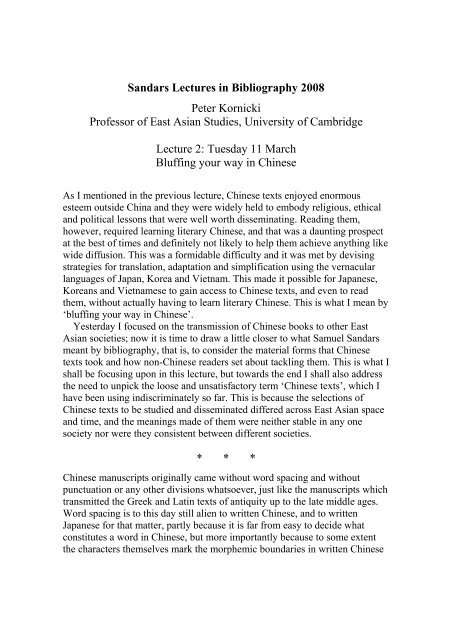
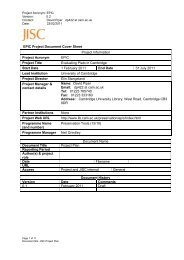

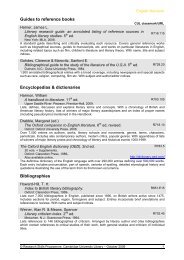
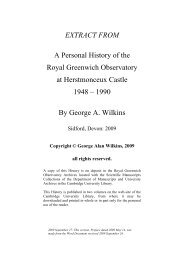
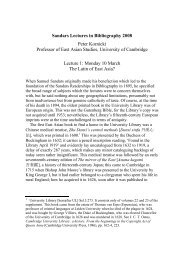
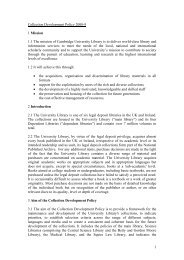

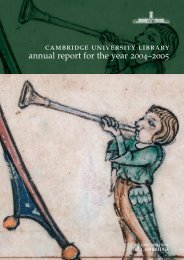

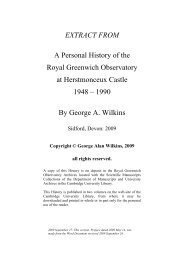

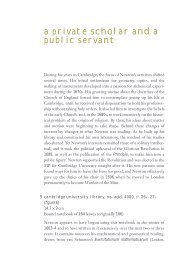
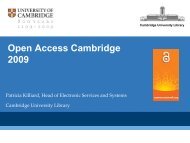
![2002-2003 [PDF] - Cambridge University Library - University of ...](https://img.yumpu.com/33538497/1/184x260/2002-2003-pdf-cambridge-university-library-university-of-.jpg?quality=85)